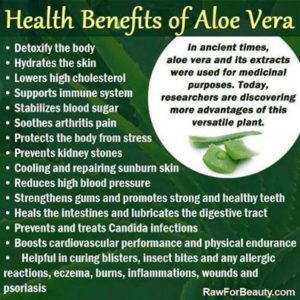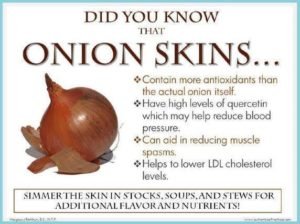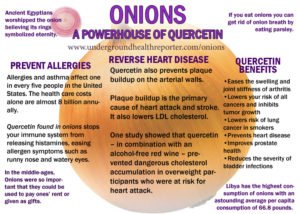by Susan Dean | Feb 2, 2018 | Health, Kitchen Recipes, Medicinal Recipes

MEDICINAL QUALITIES OF ALOE VERA
Aloe Vera is a plant that can improve the health of the cells throughout the body and works externally and internally. Externally, Aloe Vera contains astringent properties causing contraction of the skin, blood vessels, and other tissues, and is an emollient to soften and smooth skin. It’s an antifungal, anti-bacterial, an anti-viral, and a cell proliferant, quickly growing new cells.
Internally it helps lower cholesterol and improves circulation in the lower extremities. The enzymes in Aloe Vera improve digestion and nutrient absorption and help bring the body to a pH balance. It’s been known to flush out harmful germs and rebuild beneficial flora, soothing indigestion, IBS, colitis and stomach acidity.
Aloe-emodin affects the activity of Helicobacter pylori, a bacterium responsible for causing stomach ulcers. Aloe Vera is effective against E. coli, Salmonella, and Streptococcus.
Aloe makes certain viruses non-functional and is virucidal to herpes simplex virus type 1 and type 2, varicella-zoster virus, pseudo-rabies virus, and the influenza virus. It is anti-inflammatory and has a steroid-like action without side effects.
Aloe has the ability to suppress or inhibit malignant cancer cell growth. Aloe Vera, an immune stimulant, contains one of the polysaccharides that dramatically increase white blood cells or macrophages and T cells. It helps enlarge the thymus gland that produces the T cells of the immune system.
It has very strong anti-oxidant nutrients with free radical action in the A, C, and E vitamins and rids the body of toxins and carcinogens from pollution and poor quality foods.
The plant has the unique ability to increase production of fibroblast cells in the skin. Fibroblast cells fabricate collagen, the skin’s support protein that keeps skin firm, supple, and youthful looking. Aloe Vera increases collagen production, penetrates skin with nutrients up to seven layers deep, creates a barrier to stop moisture loss, and helps protect skin from damaging rays.
It is a gentle detoxifier, cleanser, and vermifuge. Use aloe juice that does not contain more than 50 ppm of aloin. Aloe flushes out dead skin cells and builds new cell growth with healthy tissue, speeding up the healing process of wounds, lesions, and ulcers. It helps heal skin damaged by radiation and aids blood flow to the skin because of capillary dilation.
Other Benefits of Aloe Vera:
- Halts growth of cancerous tumors.
- Lowers high cholesterol.
- Repairs “sludge blood” and reverses “sticky blood”
- Boosts oxygenation of blood.
- Eases inflammation and soothes arthritis pain.
- Protects the body from oxidative stress.
- Prevents kidney stones and protects the body from oxalates in coffee and tea.
- Alkalizes the body
- Cures ulcers, IBS, Crohn’s disease and other digestive disorders
- Halts colon cancer, heals the intestines and lubricates the digestive tract.
- Ends constipation.
- Reduces high blood pressure by treating the cause, not just the symptoms.
- Nourishes the body with minerals, vitamins, and enzymes.
- Accelerates healing from burns.
- Stabilizes blood sugar and reduces triglycerides in diabetics.
- Prevents and treats candida infections.
- Protects the kidneys from disease.
- Functions as nature’s “sports drink” for electrolyte balance.
- Boosts cardiovascular performance and physical endurance.
- Speeds recovery from injury or physical exertion.
Making Aloe Gel
- 1/4-cup of Aloe Vera pulp
- 1 tablespoon Coconut Oil
- 4 drops of essential lemongrass oil
- 6 drops of tea tree oil or other essential oil
Cut leaves nearest the bottom and stand them in a bowl for at least an hour allowing sap to drain out. After sap has drained, wash the leaves. Cut off thorns on both sides and peel one side. Scrape gel from the leaf and put in a blender and blend until fluffy. Leave to settle. Add remaining ingredients and mix well. Pour into a clean jar.
For Hair Conditioning Treatment – Strain the mixture. Add any essential oil for fragrance. If you want to use to treat sunburn, freeze in an ice cube trays for an instant soothing and healing treatment.
Mix some of the gel with some water to make a super healthy juice, adding some organic raw honey.

by Susan Dean | Feb 2, 2018 | Health

It used to be common knowledge that baking soda could easily cure a common cold, as well as assist in numerous other ailments. What happened to all that information? Baking soda has been used to cure cancer.
“When taken orally with water, especially water with high magnesium content, and when used transdermally in medicinal baths, sodium bicarbonate becomes a first-line medicinal for the treatment of cancer, kidney disease, diabetes, influenza and even the common cold. And importantly, it is a powerful buffer against radiation exposure, so everyone should be up to speed on its use.”
Below is an article written from the book ‘Sodium Bicarbonate – Rich Man’s Poor Man’s Cancer Treatment – Second Edition’ by Mark Sircus, AC., OMD. There are a number of well known natural cancer treatments that are working today that mainstream medicine refuses to talk about.
“There are many reasons to use baking soda but one overall reason is that sodium bicarbonate is a natural substance that will not harm us, our children or the environment because is it not a chemical compound that effects nature in any kind of negative sense. Baking soda is actually a compound that is found throughout nature, in the ocean, in the soil, in our foods, and in our bodies. Baking soda is a neutralizer of many other compounds, which makes it extremely helpful as a medicine in the age of toxicity, which we are all presently passing through.
Life-threatening asthma in children is often resistant to treatment with bronchodilators and systemic corticosteroids. Recent research suggests that administering sodium bicarbonate—an ingredient commonly found in kitchens—in intravenous (IV) form can significantly improve pH and PCO2 in children with life-threatening asthma. Sodium bicarbonate can save the day when nothing else can. The only other substance we can say the same is with magnesium chloride, which when injected will save a person during cardiac arrest and pull one out of a stroke if given soon enough.
There has been work going on at the University of Arizona, using bicarbonate (baking soda) as a potential treatment for cancer. Robert J. Gillies and his colleagues have demonstrated that pre-treatment of mice with sodium bicarbonate results in the alkalinization of the area around tumors. This type of treatment has been found to “enhance the anti-tumor activity” of other anticancer drugs. This is very similar to the recently published research of injecting O2 directly into tumors where such direct administration of Oxygen facilitated the action of chemotherapy.
This year these same researchers reported that bicarbonate increases tumor pH (makes more alkaline) and inhibits spontaneous metastases. They showed that oral sodium bicarbonate increased the pH of tumors and reduced the formation of spontaneous metastases in mice with breast cancer. It reduced the rate of lymph node involvement.
When it comes to sodium bicarbonate it is an open and shut case. It is already in wide use and has been for decades, even by oncologists who do not want their patients dropping dead too quickly because of the tremendous toxicity of their treatments. Sodium bicarbonate is used routinely to keep the toxicity of chemotherapy agents and radiation from killing people or from destroying their kidneys. In relation to bicarbonate, millions of people in the world either consume bicarbonate ions in drinking water or have been treated clinically with bicarbonate in hospitals, medical centers, or emergency. Sodium bicarbonate helps to save countless lives every day.
by Susan Dean | Feb 2, 2018 | Health

| Inexpensive Superfoods
Sweet potatoes – Beta-carotene in sweet potatoes helps every cell in the body stay healthy. It neutralizes wrinkle and sun damage and helps generate new, healthy glowing skin cells. They are packed with energizing B-vitamins.
Kale – is full of vitamins, minerals and antioxidants. Kale’s filling fiber, bone-building calcium and heart-healthy omega-3 fatty acids support the body’s natural detox system.
Dried cranberries – The high antioxidant content means they may help reduce cancer and heart disease risk. They have compounds that help prevent urinary tract infections.
Milk – One eight-ounce glass is full of nine essential nutrients, (many of us fall short) including calcium, potassium, and vitamin D.
Pinto beans – Loaded with protein, fiber, energizing B vitamins and antioxidants with one of the highest antioxidant counts of all beans and cost the least.
Eggs – Protein packed and a top source of choline, known to promote brain health. Loaded with lutein and zeaxanthin, potent antioxidants shown to enhance eye health. Most of the vitamin and minerals are in the yolk. No more than seven eggs a week to keep cholesterol in check.
Black tea – Packed with flavanoids (compounds that neutralize free-radicals) that help the every cell in our bodies. Studies show tea sippers have less skin wrinkling as they age. Decaf and herbal varieties don’t offer the same benefits.
Oatmeal – Packed with essential minerals like zinc, magnesium and iron and flavanoids that reduce disease-causing inflammation in the body. A top source of soluble-fiber that helps sweep cholesterol out of the body and keep blood sugar from rising too quickly.
Wild salmon – Four-ounces has a day’s worth of omega-3 fatty acids that reduce inflammation in the body and the risk of heart disease and cancer. It has the daily value for vitamin D and other important minerals. Wild salmon is lowest in contaminants.
Mango – High in immune-boosting vitamin C, potassium, fiber, and the healing power from its phenols, plant compounds with potent antioxidant activity. |
|
|
by Susan Dean | Feb 2, 2018 | Benefits of Certain Foods, Health
 Let’s Think About Onions
Let’s Think About Onions
Different varieties of onions vary greatly in the amount of health-promoting benefits they deliver. Onions are a major source of two types of phytonutrients that protect against cardiovascular disease, cancer and asthma. The onions you choose and the way you prepare them make a huge difference in the amount of beneficial compounds, and antioxidant and anti-cancer effects you receive.
Generally, the more pungent onions give us more benefits. Of those available in the U.S., shallots have the most phenols, and Western Yellow onions have the most flavonoids, such as quercitin, noted for its asthma-protective effects. When tested against liver and colon cancer cells, Western Yellow, New York Bold and shallots were most effective in inhibiting their growth. Purple onions contain anthocyanins, the compounds found in cardio-protective purple grapes, berries and red wine.
Summer onions (such as Walla Walla, Vidalia and Maui Sweet Onions), have a higher sugar content and a lower phytonutrient content, so do not provide the same level of health-promoting properties.
Onionskins have powerful antioxidant and anti-inflammatory powers. They provide a rich source of flavenoids, including quercetin, a very powerful antioxidant and anti-inflammatory compound. It is being studied as an agent for lowering LDL cholesterol and blood pressure, fighting allergies, reducing inflammation, enhancing muscle growth and function, treating depression, some forms of cancer, and other conditions.
“Plants are the master chemists,” says Mary Ann Lila, who directs the Plants for Human Health Institute at North Carolina State University. “Because plants can’t move around, they have to manufacture what they need, not merely to grow, but to defend, protect, and heal themselves. It makes sense that the compounds plants produce in response to stress would help a human under similar circumstances.” It makes sense that plants would concentrate many of these protective compounds in the outer coverings—the skins and peels of various roots and fruits–the point where most environmental assaults would likely occur.
To extract quercetin and other beneficial plant compounds that onions skins might contain, toss a whole onion or two, scales and all, into the pot next time you make soup, put a stew into the crock pot, or cook rice. A nice side benefit: onion skins will impart a rich brown or deep mahogany color to your broth, depending on which color onion you use.
Ethnobotanist James Duke recommends an infusion of onionskins as a soothing wash for the itch of scabies and other skin disorders. Onionskins make gorgeous dyestuffs for natural fibers.
Do a lesson on onions for your classroom. Study that onion carefully. See if they can identify the different kinds that you have. Soak some skins and dye something.
I heard Tiny Tim sing the song “Onions, Onions, La La La” a long time ago, and it is such a catchy little tune and fun to sing. Kids would love learning it. Just put some onions in a bowl and see how many days till they start sprouting. Plant some chives outside and start a great little herb garden that will be a great teaching aid and pleasure to the senses!
Onion skins for health
The outer skins of onions have powerful antioxidant and anti-inflammatory powers and provide an exceptionally rich source of plant compounds called flavenoids, especially the powerful antioxidant and anti-inflammatory compound, quercetin. Quercetin is under study as an agent for lowering LDL cholesterol and blood pressure, fighting allergies, reducing inflammation, enhancing muscle growth and function, treating depression, some forms of cancer, and other conditions.
“Plants are the master chemists,” says Mary Ann Lila, who directs the Plants for Human Health Institute at North Carolina State University. “Because plants can’t move around, they have to manufacture what they need, not merely to grow, but to defend, protect, and heal themselves. It makes sense that the compounds plants produce in response to stress would help a human under similar circumstances.” It makes sense that plants would concentrate many of these protective compounds in the outer coverings–skins and peels of various roots and fruits–the point where most environmental assaults would likely occur. To extract quercetin and other beneficial plant compounds that onions skins might contain, toss a whole onion or two, scales and all, into the pot next time you make soup, put a stew into the crock pot, or cook rice. A nice side benefit: onion skins will impart a rich brown or deep mahogany color to your broth, depending on which color onion you use.
Ethnobotanist James Duke recommends an infusion of onionskins as a soothing wash for the itch of scabies and other skin disorders. Onionskins make gorgeous dyestuffs for natural fibers.

Vidalia Onion


by Susan Dean | Feb 2, 2018 | Benefits of Certain Foods, Health

The Health Benefits of Kelp
Kelp is a brown sea vegetable that grows in almost every ocean on Earth. It is known for its rapid speed of growth, with certain species having the ability to grow half a meter per day until their optimum length (often as long as eighty meters) is reached. Because of its length and its predictable habit of remaining in thick forests in deep water, kelp is easily harvested and is a popular ingredient in East Asian dishes. It is widely available to purchase in the East and the West, both as a standalone food product and as a health supplement in tablet and capsule form.
The benefits of kelp are many. It is a good source of iodine and contains high amounts of iodine, which helps to improve thyroid function (iodine regulates thyroid hormones), maintains the health of our metabolism and immune system, and guards us against radiation poisoning. It has anti-inflammatory properties – Like hijiki and other brown algae, kelp contains the sulfated carbohydrate molecule fucoidan, which is a potent anti-inflammatory. It is a good source of iron. Like most sea vegetables, kelp contains a large amount of iron, an essential mineral that is responsible for supplying our blood cells with oxygen. Many people across America suffer from a deficiency in iron, which can lead to chronic fatigue, skin ailments, brittle fingernails, and more. Like blueberries and several other super foods, kelp contains antioxidants, which are substances that can protect our bodies’ cells from free radicals and other potentially hazardous elements.
by Susan Dean | Feb 2, 2018 | Benefits of Certain Foods, Health
 ;Molasses are a viscous by-product of the processing of sugar cane, grapes, or sugar beets into sugar. The quality of molasses depends on the maturity of the sugar cane or sugar beet, the amount of sugar extracted, and the method of extraction. Sweet sorghum syrup is known in some parts of the United States as molasses, though it is not true molasses.
;Molasses are a viscous by-product of the processing of sugar cane, grapes, or sugar beets into sugar. The quality of molasses depends on the maturity of the sugar cane or sugar beet, the amount of sugar extracted, and the method of extraction. Sweet sorghum syrup is known in some parts of the United States as molasses, though it is not true molasses.
The three grades of molasses are: mild or Barbados (first molasses); dark, or second molasses; and blackstrap.
To make molasses, the cane of a sugar plant is harvested, stripped of its leaves, the juice is extracted (crushing or mashing), and it’s boiled to concentrate it. The result of the first boiling is first molasses, which has the highest sugar content. Second molasses is created from a second boiling and sugar extraction and has a slight bitter tinge to its taste. The third boiling of the sugar syrup yields blackstrap molasses, known for its robust flavor. The majority of sucrose from the original juice has been crystallized and removed.
The calorie content of blackstrap molasses is mostly from the small remaining sugar content. Unlike refined sugars, it contains trace amounts of vitamins and significant amounts of several minerals. Blackstrap molasses is a source of calcium, magnesium, potassium, and iron. One tablespoon provides up to 20% of the daily value of each of those nutrients. Blackstrap has long been sold as a health supplement. It is also used in the manufacture of ethyl alcohol for industry and as an ingredient in cattle feed.
Sugar beet molasses is about 50% sugar by dry weight, predominantly sucrose but contains significant amounts of glucose and fructose. It is mainly used as an additive to animal feed.
Blackstrap molasses may be used as an iron supplement for those who cannot tolerate the constipation associated with other iron supplements.
Each tablespoon of molasses (20 g) contains 58 kcal, 14.95 g of carbohydrates, and 11.1 g of sugar. Molasses contains no protein or dietary fiber and close to no fat
Blackstrap molasses is the third and highest grade of molasses, differing from other grades of molasses. It has a much fuller and more robust flavor. Made from mashing and boiling sugar cane three times, blackstrap serves as a healthy natural alternative to many processed sweeteners. Blackstrap Molasses is considered by some health researchers as a holistic treatment for a range of ailments. Blackstrap is a great ingredient to have at hand for any health-conscious cook.
It is great for people who have glucose or blood sugar level issues since it has a low glycemic index. The glucose and carbohydrates in molasses are broken down much slower than in processed sugars. They require much less insulin for the body to process and are healthier for those with blood-sugar issues such as diabetes.
Blackstrap is high in iron, a vital mineral used by the body in its production of red blood cells. The high iron makes blackstrap a great choice for those trying to overcome anemia. Iron supplements tend to cause nausea and constipation for people with sensitive stomachs. Blackstrap is a healthy alternative for those looking to boost their iron intake without dealing with the side effects of artificial treatments. It’s a great source of calcium and a source of potassium, magnesium, copper, and manganese. Many people claim to have reversed their gray hair with it. Probably partly due to the copper content. Copper deficiency can lead to prematurely gray hair.
Copper, an essential component of many enzymes, plays a role in iron utilization, elimination of free radicals, development of bone and connective tissue, and the production of the skin and hair pigment called melanin. Using two teaspoons of blackstrap molasses to sweeten your morning cereal and the coffee or tea you drink will supply you with 14.0% of the daily-recommended value for copper.
People claim that molasses cured cancer, acne, arthritis, and everything in between.
Molasses can be added to the soil of almost any plant or to the compost pile to promote microbial activity.










 ;
;